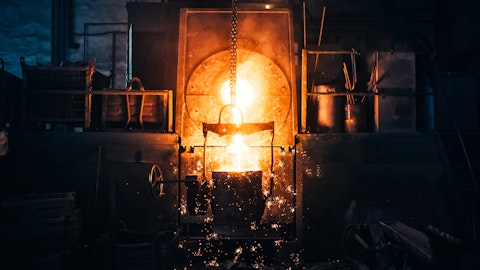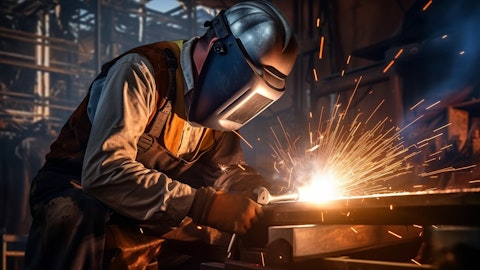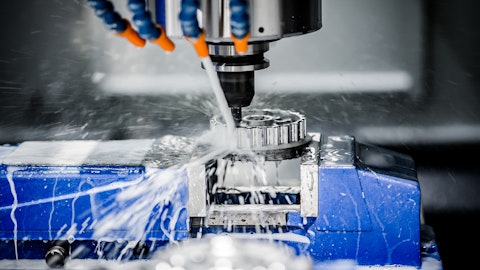Algoma Steel Group Inc. (NASDAQ:ASTL) Q3 2024 Earnings Call Transcript February 7, 2024
Algoma Steel Group Inc. isn’t one of the 30 most popular stocks among hedge funds at the end of the third quarter (see the details here).
Operator: Hello, and welcome to today’s conference call to discuss Algoma Steels fiscal third quarter 2024 Financial Results. My name is Paul, and I’m your operator for today’s call. At this time, I would like to hand the call over to Mike Moraca Treasurer and Investor Relations Officer for Algoma. Mr. Moraca, please go ahead.
Mike Moraca: Good morning, everyone, and welcome to Algoma Steel Group Inc. Third Quarter Fiscal 2024 Earnings Conference Call. Leading today’s call are Michael Garcia, our Chief Executive Officer; and Rajat Marwah, our Chief Financial Officer. As a reminder, this call is being recorded, and will be made available for replay later today in the Investors section of Algoma Steel’s corporate website at www.algoma.com. I would like to remind you that, comments made on today’s call may contain forward-looking statements within the meaning of applicable securities laws, which involve assumptions and inherent risks and uncertainties. Actual results may differ materially from statements made today. In addition, our financial statements are prepared in accordance with IFRS, which differs from US GAAP, and our discussion today includes references to certain non-IFRS financial measures.
Last evening, we posted an earnings presentation to accompany today’s prepared remarks. The slides for today’s call can be found in the Investors section of our corporate website. With that in mind, I would ask everyone on today’s call to read the legal disclaimers on slide 2 of the accompanying earnings presentation, and to also refer to the risks and assumptions outlined in Algoma Steel’s third quarter fiscal 2024 management’s discussion and analysis. Please note that, our financial statements are prepared using the US dollar as our functional currency and the Canadian dollar as our presentation currency. Our fiscal year runs from April 1 to March 31, and our financial statements have been prepared for the three and nine months ended December 31, 2023.
Please note all amounts referred to on today’s call are in Canadian dollars unless otherwise noted. Following our prepared remarks, we will conduct a question-and-answer session. I will now turn the call over to our Chief Executive Officer, Michael Garcia. Mike?
Michael Garcia: Thank you, Mike. Good morning and thank you for joining us to discuss our fiscal third quarter results. As is customary, I’ll start by highlighting our top priority, the safety of our employees. At Algoma, we uphold an unwavering commitment to safety, which has resulted in a notable improvement to lost time injury performance year-to-date. While our site remains bustling with activity, it’s crucial to underscore the significance of safety particularly as our EAF project progresses with increase in contractor involvement. We remain steadfast in our pursuit of zero workplace injuries. Next, I’ll cover key events and milestones during our fiscal third quarter and subsequent to events, as well as giving an update on progress at our transformative EAF project.
I will then turn the call over to Rajat for a deeper dive into the numbers and a discussion of our strong liquidity and balance sheet, before closing with an update on market conditions. There are a few important things I would like to get across on this call. Our long-term strategy remains unchanged and on track to successfully execute the transition to being one of North America’s greenest producers of steel. Our results for the quarter were comfortably in line with our expectations. Our facilities are back online with a goal of reaching full production as quickly and safely as possible, following the coke-making utility structure collapse. And finally, the outlook for our end markets calls for an improvement in pricing relative to calendar year 2023.
Now, let me give you some additional color on those key themes. Our results for the fiscal third quarter of 2024 were in line with our previously disclosed guidance on both shipments and adjusted EBITDA, and we achieved year-over-year improvements in nearly all of our key metrics. As a reminder, our fiscal third quarter included major seasonal maintenance, which was completed as planned ahead of the winter months. Due to the lagging nature of our order book, realized pricing in the quarter did not yet reflect the run-up in markets around the end of the UAW strike. That stronger pricing is expected to begin benefiting our financial results in the fiscal fourth quarter, which unfortunately will be largely offset by impacts related to the outage caused by the incident at our coke-making plan that I will discuss in more detail shortly.
Our fiscal third quarter is typically a busy one in terms of seasonal maintenance, and this year was no exception. In totality, the work was completed as planned. We also built seasonal inventories for our normal practice going into the end of the calendar year. During the quarter, we made additional progress on Phase II of our plate mill modernization project, including bringing the in-line share online and ramping up its production through the end of the year. We expect higher production levels of plate going forward, which will allow us to capture market opportunities and to build inventory ahead of the planned outages for the implementation of the final pieces of the modernization project. As a reminder, we have split the originally planned 40-day outage into two shorter duration outages with the first outage scheduled in April and the second outage planned for late calendar year 2024 to align with other planned maintenance activities providing some efficiencies on downtime.
Next I’d like to update you on the progress during the quarter on our transformational electric or EAF project. The EAF will ultimately increase our throughput capacity by roughly a third from CAD2.8 million tons per year of liquid steel making capacity by conventional means today for CAD3.7 million tons employing dual furnaces upon completion. The higher output will match our expanded downstream finishing capacity as we increase capacity at our plate mill. We will improve overall product mix and lower our carbon emissions by approximately 70% when fully operational. When factoring in the makeup of our power supply when we switch to EAF operations we expect to be one of the greenest producers of steel in North America. During the quarter, cumulative investment in the EAF project reached CAD510 million.
To-date, we have committed contracts totaling approximately CAD750 million with approximately 7% tied to time and material contracts, while the balance is fixed price in nature. We expect to contract the majority of the remaining project elements by the end of the current quarter. This will significantly derisk the EAF project budget as we progress towards our expected commissioning in late calendar year 2024. As a reminder, our start-up plan continues to include normal production from our existing steelmaking facility, while ramping up steel production from our EAFs in calendar year 2025, followed by a complete switch to EAF production. Before I hand it over to Rajat, let me give you an update on our operations currently. As we previously disclosed on January 20 and January 23, there was an incident at our coke making plant that involved the collapse of a structure supporting utilities plankton.

Thankfully there were no injuries. But the event did impact several utilities that service the coke batteries and other facilities throughout the steelworks. Coke making operations were suspended at the time of the incident and we were able to stabilize heat to all three batteries and resume partial coke production within 72 hours of the incident. When factoring in coke inventories on hand, the availability of third-party coke and our partial production capabilities, we are able to satisfy all of our steel-making raw material input, while at the same time pursuing a permanent repair plan for the plant. As we also disclosed previously at the time of the incident, we temporarily suspended blast furnace operations for safety reasons. The blast furnace experienced operational challenges upon initial restart due to unforeseen impacts related to the piping collapse.
All necessary repairs to the blast furnace have been completed and the furnaces gradually being brought back online. Usable hot metal is expected to be produced within the next seven days with the return to full production anticipated within the next two weeks. Most importantly, we will undertake these recovery efforts with the safety of our employees and our community at the forefront. While doing this we continue to advance the EAF project on schedule. I’d like to once again thank all of our employees for their hard work, dedication and professionalism. Now I will pass the call over to Rajat to go over our financial results for the quarter. Rajat?
Rajat Marwah: Thanks, Mike. Good morning and thank you all for joining the call. As a reminder all numbers are expressed in Canadian dollars unless otherwise noted. We shipped 516,000 tons in the quarter up 12.6% as compared to the prior year period. Our plate and strip operations ran well in the quarter even as we completed a normal seasonal maintenance including our annual steelmaking vessel inline. Net sales realization averaged CAD1,079 per ton down 3.3% versus the prior year period. The decrease versus the prior year level primarily reflects somewhat softer market conditions in the quarter, in particular the residual lower prices resulting from the UAW strike and due to the lagging nature of our order book. Plate pricing continued to enjoy a significant premium relative to hot-rolled coil during the quarter, driven by resilient demand particularly from spending on infrastructure projects and durables goods.
Steel revenue in the quarter totaled CAD 556.9 million, up 8.8% versus the same quarter of last year reflecting the increase in shipments that more than offset lower average realizations per ton of steel. On the cost side, although most cost per ton of steel products sold averaged 10.07 in the quarter, down 11.2% versus the prior year period. The decrease versus the prior year period is primarily attributable to favorable leverage on higher volumes. This resulted in adjusted EBITDA in the quarter of negative CAD 1 million and adjusted EBITDA margin of negative 0.2%, an improvement from negative CAD 35.9 million and negative 6.3% in the year ago period. Cash used in operations totaled CAD 47.4 million for the quarter compared to a use of CAD 128.6 million in the prior year period.
Our inventories at the quarter end were CAD 886.6 million, up 7.8% during the quarter due to normal seasonal build patterns ahead of winter. We would typically expect to release inventories in the first half of calendar 2024, heavily weighted towards the first calendar quarter. But the impact of the Coke-Making plant incident will result in higher levels of inventory for inputs like ore and coal, delaying some of that anticipated inventory release. Looking prospectively, we do expect the fourth fiscal quarter to experienced directionally higher EBITDA versus the third fiscal quarter. Promised performance will obviously be impacted by the production outage related to the utility structure collapse. All told, we expect the incident to impact production and shipments for more than three weeks, totaling roughly 120,000 tons to 150,000 tons.
It should be noted that Algoma carries standard insurance coverage that is intended to protect the company at times like this including business interruption insurance. We have begun the process of submitting claims under our policy for covered losses and insurance adjusters and advisers were on-site and so similarly, we are working closely with them to secure our protection. We expect to have more details on this front in coming months. From a working capital perspective, we had mentioned on our previous call that we expect to release a total of CAD 150 million by the end of fiscal 2025, with approximately CAD 100 million of working capital drawdown in the fourth fiscal quarter of 2024. On account of the Coke-Making utility structure collapse and the related operational outages, we expect to release 70% less than originally expected amount in the fourth fiscal quarter.
This timing issue will result in us releasing the balance over the subsequent quarters and we still expect to release approximately CAD 150 million over this period. I would like to provide a reiteration of our funding plans for the year projects. As previously noted, our outlook for total cost of the project remains in the range of CAD 825 million to CAD 875 million. Towards the end of the quarter, we had spent CAD 510 million or 60% of expected total, leaving CAD 340 million of investment demand. We are well positioned today and we look at our expected sources for those expenditures over the course of 2024. We have structured our balance sheet such that the only long-term debt we carry is in the form of government loans linked to our capital projects, allowing us to maintain a very low leverage profile, with ample liquidity of nearly CAD 400 million at quarter end to manage through market fluctuation and complete our capital initiatives.
We have cash on hand of nearly CAD 95 million, another CAD 76 million of available capacity on our Federal CEF loan, and approximately CAD 150 million of cash to be generated from working down excess working capital in the months ahead. Combined, this roughly matches the expected capital requirements to complete the project, highlighting our ability to advance this transformative project as planned. I’d now like to turn the call back to our CEO, Michael Garcia for closing comments. Mike?
Michael Garcia: Thank you, Rajat. Looking at the state of the North American steel market, hot-rolled coil index prices moved dramatically higher in October, as the settlement and the UAW strike became apparent and steel consumers rush to replenish their inventory needs. Over the calendar fourth quarter, pricing moved from the mid-$600 range to touch nearly $1,100 per net ton by the end of the year. Pricing so far in 2024 has come in with index prices dropping by approximately $50 and futures falling into the mid $800 per ton US average for the balance of 2024, while off from year-end highs these prices still represent a meaningful improvement from levels seen during much of 2023. As Rajat mentioned, we are also supported by the fact that plate pricing continues to demonstrate a significant premium as overall demand for plate products remains high and this in turn continues to benefit our average price realizations, especially as we ramp up operations in our plate mill.
2024 will be an important year in the story of Algoma as we continue to execute work towards the commissioning of our transformative EAF project. This will usher in the next phase of our Company that defines the future of Algoma provides the foundation for long-term value creation for our stakeholders and solidifies our leadership position at the forefront of green steel production in North America. Thank you very much for your continued interest in Algoma Steel. At this point, we would be happy to take your questions. Operator, please give the instructions for the Q&A session.
See also 20 Big Hotels Where AARP Members Can Get Discounted Rates and 25 Countries where Muslim Population will Increase the Most by 2030.
Q&A Session
Follow Algoma Steel Group Inc. (NASDAQ:ASTL)
Follow Algoma Steel Group Inc. (NASDAQ:ASTL)
Operator: Thank you. We will now be conducting a question-and-answer session. [Operator Instructions] Our first question is from David Ocampo with Cormark Securities. Please proceed with your question.
David Ocampo: Thanks for taking my questions. My first one is just on a bigger picture question. I guess, when you look to 2025, you guys have always discussed being a hybrid operator and either tilting towards being a pure-play EAF or throwing in a little bit of your blast furnace there. When you think about the issues that just happened with the coke facility and even the blast furnace, does that change your tune on what you guys ultimately decide for 2025 or is it just going to come down to cost? I’m curious on your thoughts there.
Michael Garcia: Hi, David. This is Mike. Yes, I think that right now our plan still remains to operate in 2025 in a hybrid mode. That’s been the plan for some time as well as we think it makes the right financial sense as well and obviously, financially we’ll continue to keep a very close eye on that. Given the incident in the past two weeks, we’ll have to understand the state of the assets and make sure we’re comfortable with the asset integrity of both blast furnace, which we pay a lot of attention to and it features very prominently on our asset integrity and asset reliability plan, but as well as the coke ovens. But assuming nothing significantly changes in either one of those perspectives or analysis, we feel comfortable with our current plan.
David Ocampo: Got it. And it may be early days, and maybe this one’s for Rajat, but how should we be thinking about the cost structure when you guys are hybrid operator is it no cost plus type model or just curious what the added costs will be with the dual cost structure, DuPont – dual manufacturing process?
Rajat Marwah: Hi, David. The best way to look at it is that we will be operating an additional facility, which is the electric arc facility. And as we indicated in the past, it probably will carry 100 to 140 people more from a mining perspective, which is — which becomes your fixed cost then the rest most of it becomes variable in the form of using metal in the electric arc furnace or using metal through the blast furnace. So, as far as, you know the added fixed cost is concerned, it’s that and the maintenance costs will not be much as it is a new asset. So we don’t expect it to be substantially higher as we go through it. It definitely will be higher as we are transitioning and as the as we transition and start shutting down the facilities and start reducing the fixed costs on those facilities the costs will start coming down.
David Ocampo: And last one for me Rajat. You gave some capital plans at least as it relates to the year I was hoping you could square up the total CapEx for this year broken down by maintenance, the plate modernization and then layering on the app on top of that?
Rajat Marwah: So then when you say this year, you’re talking of 2025 fiscal?
David Ocampo: I guess 2024 calendar.
Rajat Marwah: 2024 calendar. So, yeah, pretty much should be should be in line. So it should be a little roughly a CAD250-odd million on year that we’ll be spending from a CapEx perspective. And this is gross CapEx, not net, and then we will be spending on our maintenance. It’s roughly CAD100 million to CAD120 million on our maintenance CapEx. That could be we’ll be spending, so that’s your total. So there is some plate mill CapEx that will be spent in the first quarter, and little bit later on — to complete the complete replacement projects. And that’s how the CapEx will run. That is the money spent on recovery of the coke batteries, which definitely will form part of the whole analysis that we’re doing along with insurance, but that will be in addition.
David Ocampo: Got it. Thanks so much. I’ll hand the call over.
Operator: Thank you. Our next question is from Katja Jancic with BMO Capital Markets. Please proceed with your question.
Katja Jancic: Hi. Thank you for taking my questions. First just to confirm, you expect EBITDA to be higher sequentially in 4Q?
Rajat Marwah: That’s correct.
Katja Jancic: And that’s mostly going to be driven by pricing? Or is there any cost puts and takes there?
Rajat Marwah: It’s mostly will be pricing, cost will be pretty similar and from variable cost perspective fixed cost depending on the volume definitely will be higher, but it’s mostly coming from pricing.
Katja Jancic: And this currently assumes three weeks of lost production right?
Rajat Marwah: Yeah, roughly 120,000 to 150,000 tons of production and shipment.
Katja Jancic: And maybe just on the blast furnace, close to needing a full reline, is there a risk that that complicates the restart?
Michael Garcia: Hi Katja. This is Mike. No not really. I think the up the blast furnace disruption, it was more related to the utility service incident at coke making, we’ve restarted it and are slowly bringing it back to good. I don’t think the time since the last reline is really a factor into the incident that happened, or the state that we’ll get it back to once we’re making good metal. Does that help?
Katja Jancic: Yes. Thank you. I’ll hop back into the queue.
Operator: Thank you. Our next question is from Ian Gillies with Stifel. Please proceed with your question.
Q – Ian Gillies: Good morning, everyone.
Michael Garcia: Good morning, Ian.
Q – Ian Gillies: Just to reconfirm on the working capital numbers you provided, do you suggesting that for fiscal year 2024 it will be call it a CAD40 million to CAD50 million release. And then in fiscal year 2025, we’re looking at another CAD100 million release?



